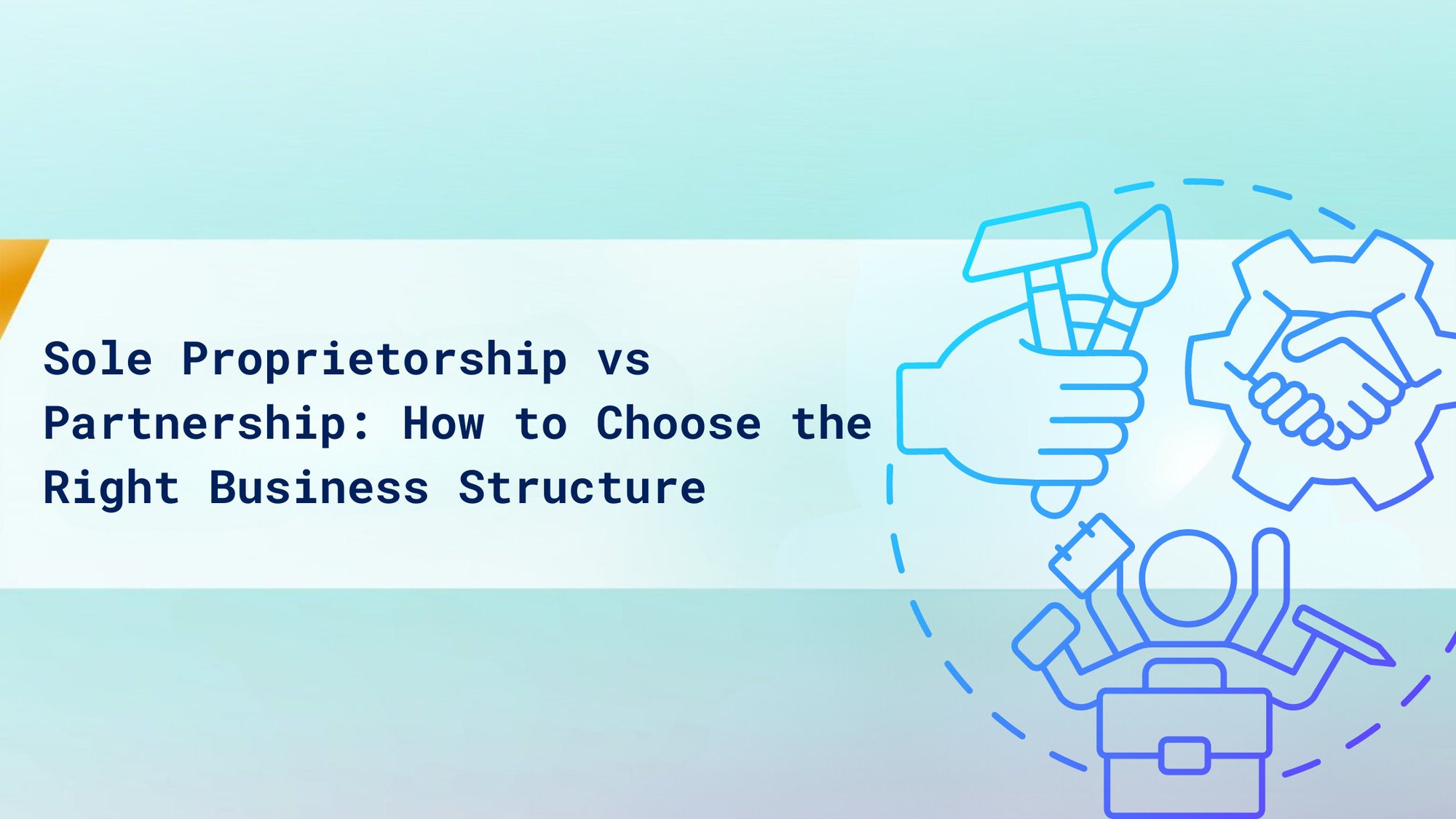
Sole Proprietorship vs Partnership: How to Choose the Right One
Author Taiwo Temitope-Adesope
Deciding on the most suitable business structure is one of the most critical choices entrepreneurs make when starting a business. The options typically boil down to sole proprietorship, partnership, corporation or limited liability company (LLC). Each has its own advantages and disadvantages relating to ownership, liability, taxes, profit-sharing and raising capital. In this blog post, we provide an in-depth look at the difference between sole proprietorships and partnership. Understanding the key differences is crucial, as they have vastly different implications legally, financially and operationally.
We break down how they compare across factors like decision-making authority, liability, financing and continuity. Real-world examples demonstrate when each makes sense and how transitions between them work.
Whether just starting out or looking to shift an existing business’ structure, use this as a guide to determine if sole proprietorship or partnership is better aligned to your entrepreneurial goals and risk-tolerance.
What is Sole Proprietorship?
A sole proprietorship is the simplest business structure, owned and controlled by one individual who is personally responsible for all assets, debts and liabilities. It is not considered a separate legal entity like a corporation.
Key characteristics include:
- Single owner has complete control and decision-making power.
- No requirement for formal agreements or registration.
- Owner assumes unlimited personal liability for all debts and obligations.
- No separation between business and personal assets.
- Easy to form and operate with minimal legal restrictions.
- All profits flow directly to the sole proprietor.
Advantages of sole proprietorships include:
- Complete freedom and flexibility in operations.
- Low startup costs and legal formalities.
- Tax advantages as profits are taxed only once personally.
- All profits go to the sole owner.
Disadvantages include:
- Unlimited personal liability which can put personal assets at risk.
- Lack of shared decision-making and specialized expertise.
- No continuity of business if owner dies, becomes disabled or exits the business.
- Limited access to financing and capital for growth due to single ownership.
But don't let these challenges hold you back! nairaCompare empowers sole proprietors like you to take control of your finances and secure the funding you need to thrive.
With nairaCompare, you can:
- Compare Loans from Multiple Lenders: Access a wide range of loan options from various lenders, ensuring you find the best fit for your business needs.
- Find the Best Rates and Terms: Compare interest rates, repayment schedules, and fees to secure the most favourable loan terms possible.
Ready to take your sole proprietorship to the next level? Visit nairaCompare today and unlock a world of financing possibilities. Don't settle for limited options – compare, choose, and fund your business!

What is a Partnership?
A partnership is a business structure owned jointly by two or more co-owners (partners). Partners share control over operations and contribute skills, money or assets. Profits, losses and liabilities are also shared by partners based on negotiated percentages.
There are different types of partnerships like general partnerships, limited partnerships (LPs), limited liability partnerships (LLPs) and joint ventures. Each has distinct profit-sharing, control, liability and tax implications.
Key advantages of partnerships are:
- Broader pool of capital, skills and expertise via combined resources.
- Shared decision-making, responsibilities and workload.
- Potential for greater continuity and credibility than sole ventures.
- Possible tax benefits as profits flow through to personal returns.
Disadvantages include:
- Lack of full control and shared authority.
- Joint and several liability, exposing personal assets (except for LLPs/LPs).
- Potential for conflicts and deadlocks between partners.
- Divided profits dilute individual earnings.
- Dissolution if any partner dies, exits or goes bankrupt.
Difference between sole proprietorship and partnership
Some key differences stand out:
- Sole proprietors enjoy unilateral control over decisions while partners must collaborate and compromise, which has pros and cons.
- Personal assets are shielded from liability in partnerships (for LLPs/LPs), reducing financial risks.
- Pooling resources expands financing capabilities and specialization for partnerships.
However, partnerships see diluted earnings from profit-sharing and heightened risks of conflict or deadlock. Sole proprietors thus retain full command over their vision.
Financial Management
Sole proprietors handle finances singlehandedly – planning, budgeting, reporting and filing taxes using personal accounts. This grants flexibility but can be burdensome.
Partners must agree on financial systems and sharing via partnership agreements. They should clarify capital contributions, dividend policies, salaries, withdrawals, budgets and account keeping responsibilities. Sound financial collaboration and trust is vital.
For both, income passes directly to owners’ personal tax returns as profits. So financial discipline and quarterly estimated payments help avoid tax penalties. Maintaining separate business accounts aids transparency too.
Legal Considerations
For sole proprietorships, legal formalities are minimal – just licenses and permits to operate. Shutting down is also easy.
For partnerships, partners must develop a partnership agreement outlining all the factors above like responsibilities, dispute resolution etc. These helps avoid misunderstandings down the line.
Different types of partnerships also have varying regulations around registration and compliance under state partnership acts. These dictate duties, liabilities, dissolution and other aspects. So legal considerations are much more extensive for partnerships.
Transitioning Business Structures
Sole proprietors can transition into partnerships by taking on partners. But they must weigh the pros and cons first regarding diminished control.
Partnerships transforming into sole proprietorships require buying out the partners’ interests. Any outstanding liabilities or contracts must still be honoured after withdrawal, however.
In both cases, the legal and financial complexities mean consulting attorneys and accountants is highly advisable before transitioning structures.
Future Outlook and Trends
Partnerships are declining as more specialized options like LLCs gain Favor. LLCs offer personal liability protection absent in general partnerships. But for straightforward small/medium ventures, sole proprietorships and partnerships will remain viable and useful.
Evolving technologies may enhance connectivity and contract enforcement to facilitate online partnerships across borders too.
Conclusion
There are compelling reasons for entrepreneurs to choose either a sole proprietorship or a partnership structure. Key determining factors include desired control, risk tolerance, financing needs and plans regarding continuity.
Sole proprietorships offer unilateral command of operations while partnerships provide collaborative decision capabilities and aggregated resources. But they also demand these respective trade-offs – personal liability vs profit sharing, flexibility vs disagreement risks.
By weighing all considerations from this guide, both new and current business owners can make an informed decision between the two structures. And transitions remain a viable option should need change over time.
Ultimately, structure should flow from the underlying business vision rather than dictate it. So, aligning to long term entrepreneurial goals trumps abstract notions of an ideal structure. Let this comparison help you make that structured-yet-flexible choice!
FAQs
Q: What business structure has the easiest setup?
A: Sole proprietorships unambiguously involve the simplest, fastest and cheapest registration and setup process.
Q: Can I freely convert my sole proprietorship into a partnership later?
A: Yes, by taking on partner(s) and entering partnership agreements but consider controls/returns trade-off.
Q: Do partnerships provide any liability protection at all?
A: Yes, LLP/LP structures do extend personal liability protection unlike general partnerships.
Q: What key clauses should a partnership agreement include?
A: Profit/loss sharing terms, capital contributions, management authority, duties/responsibilities, dispute resolution, partner changes/exit policies
About Author

Taiwo Temitope-Adesope
Taiwo is a passionate storyteller and strategist dedicated to empowering women and crafting compelling narratives. A First-Class graduate in Mass Communication from Covenant University, she specializes in writing, public relations, and digital marketing. As a Content Manager at Suretree, she drove a 50% increase in web traffic through SEO and boosted website engagement by 60% in just four months. Her leadership experience includes serving as Public Relations Officer for the Covenant University Student Council and contributing to impactful volunteer initiatives. With expertise in strategic thinking and business acumen, Taiwo continues to create stories that inspire confidence and imagination.









